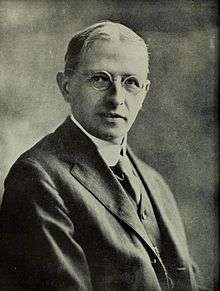Henry Norris Russell
| Henry Norris Russell | |
|---|---|
 | |
| Born |
October 25, 1877 Oyster Bay, New York, USA |
| Died |
February 18, 1957 (aged 79) Princeton, New Jersey, USA |
| Nationality | American |
| Fields | Astronomy |
| Institutions | Princeton University |
| Alma mater | Princeton University |
| Doctoral advisor | Charles Augustus Young[1] |
| Doctoral students | |
| Known for | |
| Influences |
|
| Notable awards | Gold Medal of the Royal Astronomical Society |
Henry Norris Russell (October 25, 1877 – February 18, 1957) was an American astronomer who, along with Ejnar Hertzsprung, developed the Hertzsprung–Russell diagram (1910). In 1923, working with Frederick Saunders, he developed Russell–Saunders coupling which is also known as LS coupling.[2][3][4][5][6][7][8][9]
Biography
Russell was born in 1877 in Oyster Bay, New York. He studied astronomy at Princeton University, obtaining his B.A. In 1897 and his doctorate in 1899, studying under Charles Augustus Young. From 1903 to 1905, he worked at the Cambridge Observatory with Arthur Robert Hinks as a research assistant of the Carnegie Institution and came under the strong influence of George Darwin.
He returned to Princeton to become an instructor in astronomy (1905–1908), assistant professor (1908–1911), professor (1911–1927) and research professor (1927–1947). He was also the director of the Princeton University Observatory from 1912 to 1947. He died in Princeton, New Jersey in 1957 at the age of 79.[10]
In November 1908 Russell married Lucy May Cole (1881-1968). They had four children. Their youngest daughter, Margaret, married the astronomer Frank K. Edmondson in the 1930s.
Published work
Russell co-wrote an influential two-volume textbook in 1927 with Raymond Smith Dugan and John Quincy Stewart: Astronomy: A Revision of Young’s Manual of Astronomy (Ginn & Co., Boston, 1926–27, 1938, 1945). This became the standard astronomy textbook for about two decades. There were two volumes: the first was The Solar System and the second was Astrophysics and Stellar Astronomy. The textbook popularized the idea that a star's properties (radius, surface temperature, luminosity, etc.) were largely determined by the star's mass and chemical composition, which became known as the Vogt-Russell theorem (including Heinrich Vogt who independently discovered the result). Since a star's chemical composition gradually changes with age (usually in a non-homogeneous fashion), stellar evolution results.
Controversy
Henry Norris Russell dissuaded Cecilia Payne-Gaposchkin from concluding that the composition of the Sun is different from that of the Earth in her papers, as it contradicted the accepted wisdom at the time. However, he changed his mind four years later after deriving the same result by different means. After Payne was proven correct, Russell briefly credited Payne for discovering that the Sun had a different chemical composition from Earth in his paper. However the credit was still generally given to him instead.[11]
- Henry Norris Russell; Frederick Albert Saunders (1925). "New Regularities in the Spectra of the Alkaline Earths". Astrophysical Journal. 61: 38–69. Bibcode:1925ApJ....61...38R. doi:10.1086/142872.
- Henry Norris Russell; Raymond Smith Dugan; John Quincy Stewart (1945) [1926–27, 1938]. Astronomy: A Revision of Young’s Manual of Astronomy; Vol. I: The Solar System; Vol. II: Astrophysics and Stellar Astronomy. Boston: Ginn & Co.
- Henry Norris Russell (1929). "On the Composition of the Sun's Atmosphere". Astrophysical Journal. 70: 11–82. Bibcode:1929ApJ....70...11R. doi:10.1086/143197.
- Henry Norris Russell (1937). "Model Stars (13th Josiah Willard Gibbs Lecture)". Bull. Amer. Math. Soc. 43 (2): 49–77. doi:10.1090/S0002-9904-1937-06492-5. MR 1563489.
Awards and honors
- Fellow of the American Academy of Arts and Sciences (1921)[12]
- Gold Medal of the Royal Astronomical Society (1921)[13]
- Lalande Prize (1922)
- Henry Draper Medal from the National Academy of Sciences (1922)[14]
- Bruce Medal (1925)[15]
- Rumford Prize (1925)[16]
- Franklin Medal (1934)
- Janssen Medal from the French Academy of Sciences (1936)
- Foreign Member of the Royal Society (1937)[17]
- Henry Norris Russell Lectureship (1946)[18]
- asteroid 1762 Russell
References
- 1 2 Henry Norris Russell at the Mathematics Genealogy Project
- ↑ David H. DeVorkin, Henry Norris Russell - google books
- ↑ George Kean Sweetnam, The Command of Light - google books
- ↑ Henry Norris Russell — Biographical Memoirs of the National Academy of Sciences
- ↑ Obituary MNRAS 118 (1958) 311
- ↑ Obituary Obs 77 (1957) 67
- ↑ Obituary PASP 69 (1957) 223
- ↑ DeVorkin, David H (2000). Henry Norris Russell: Dean of American Astronomers. Princeton University Press. pp. 528 pages. ISBN 0-691-04918-1.
- ↑ Bibliography in Bruce Medalist page for Russell maintained by Joseph Tenn at Sonoma State University
- ↑ Mehra, Jagdish; Helmut Rechenberg (2001). The Historical Development of Quantum Theory, Vol. 1, Part 2. Springer. p. 686.
- ↑ Padman, Rachael (2004). "Cecilia Payne-Gaposchkin (1900 - 1979)". Newnham College Biographies. Archived from the original on 2010-03-05. Retrieved 2010-03-05.
- ↑ "Book of Members, 1780-2010: Chapter R" (PDF). American Academy of Arts and Sciences. Retrieved 14 April 2011.
- ↑ "Winners of the Gold Medal of the Royal Astronomical Society". Royal Astronomical Society. Retrieved 19 February 2011.
- ↑ "Henry Draper Medal". National Academy of Sciences. Retrieved 19 February 2011.
- ↑ "Past Winners of the Catherine Wolfe Bruce Gold Medal". Astronomical Society of the Pacific. Retrieved 19 February 2011.
- ↑ "Past Recipients of the Rumford Prize". American Academy of Arts and Sciences. Retrieved 19 February 2011.
- ↑ Stratton, F. J. M. (1957). "Henry Norris Russell 1877-1957". Biographical Memoirs of Fellows of the Royal Society. 3: 173–126. doi:10.1098/rsbm.1957.0012. JSTOR 769359.
- ↑ "Grants, Prizes and Awards". American Astronomical Society. Retrieved 19 February 2011.